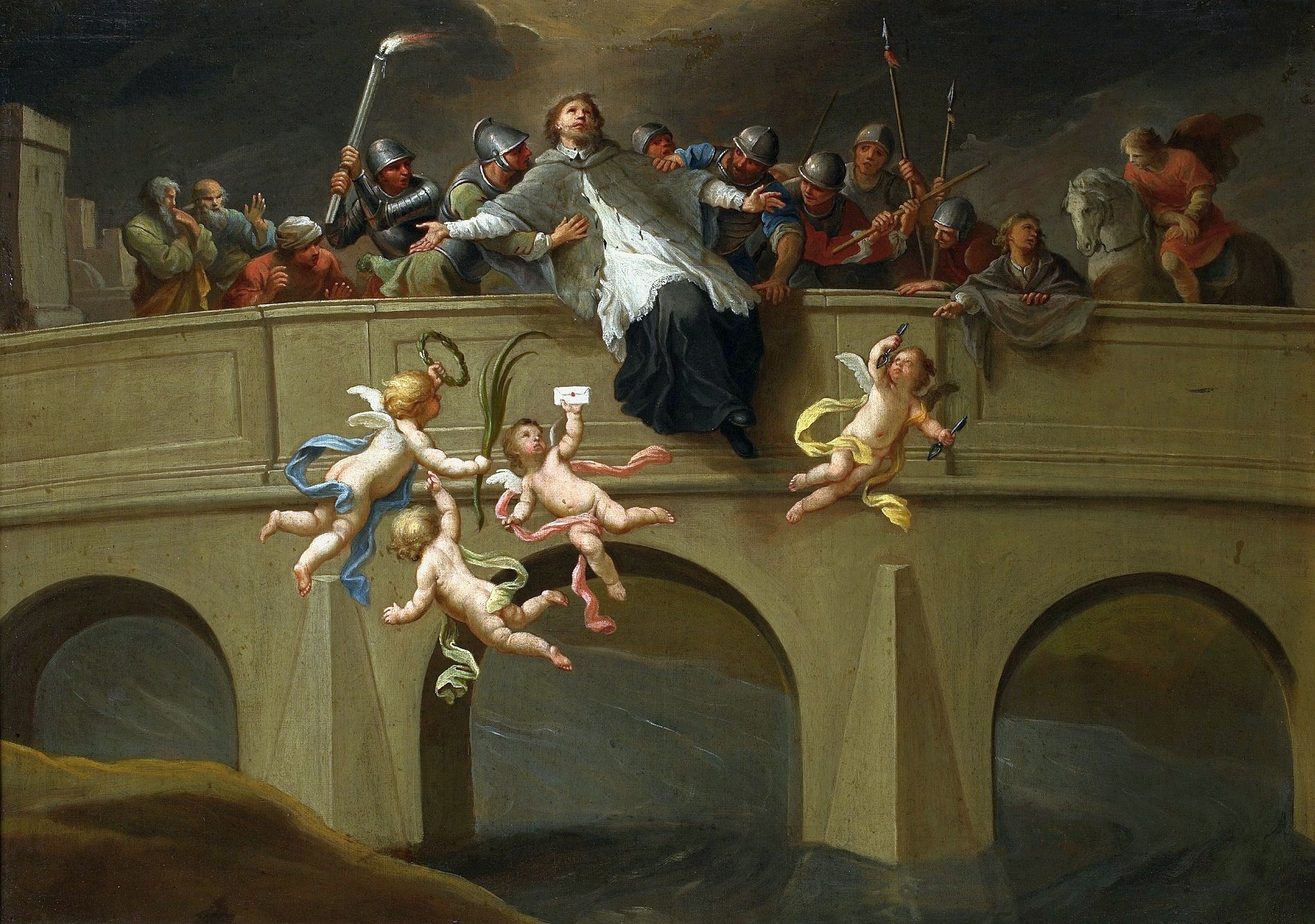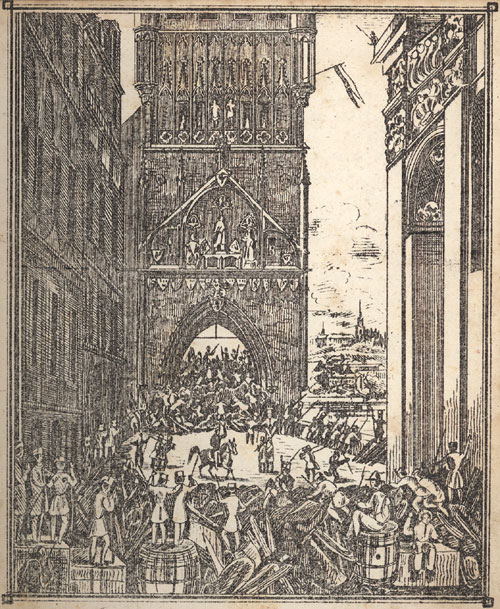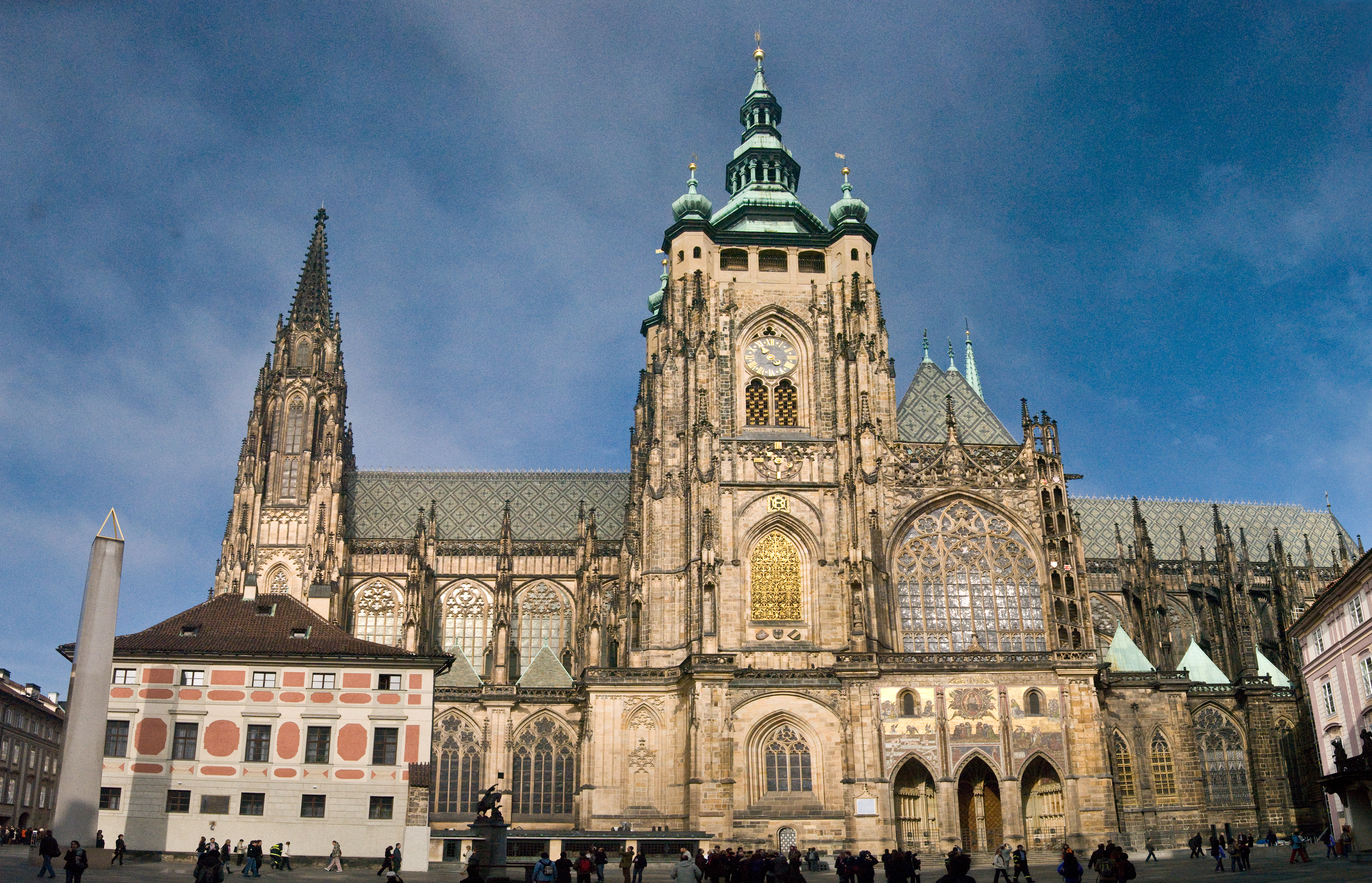|
Statue Of John Of Nepomuk, Charles Bridge
The statue of John of Nepomuk is an outdoor sculpture, installed in 1683 on the north side of the Charles Bridge in Prague, Czech Republic. It was the first of the many Baroque images of saints to be installed on the bridge. Description and history The bronze statue is based on a clay model made in 1681 by Matthias Rauchmiller. The sculptor Jan Brokoff created a large wooden sculpture based on Rauchmiller's model, which was then cast in bronze in Nuremberg. Rauchmiller's clay model is now in the collection of the National Gallery of Prague The National Gallery Prague ( cz, Národní galerie Praha, NGP), formerly the National Gallery in Prague (), is a state-owned art gallery in Prague, which manages the largest collection of art in the Czech Republic and presents masterpieces of Cze .... Brokoff's wooden statue (gilded) has been displayed on the altar of Prague's Church of St. John of Nepomuk On the Rock since 1819. References External links * {{Public art in Prague ... [...More Info...] [...Related Items...] OR: [Wikipedia] [Google] [Baidu] |
Jan Brokoff
Jan Brokoff, also known as Johann Brokoff, (23 June 1652 – 28 December 1718) was a baroque-era sculptor and carver. Brokoff was of Carpathian German origin, born in Spišská Sobota, today in Slovakia, then in Royal Hungary, and later working and living in Bohemia. He was the father of the sculptors Michael Brokoff and Ferdinand Brokoff. In 1675 Brokoff moved from Hungary and worked at various places mainly in western Bohemia. Three years later, in 1692 he settled in Prague and gained burgher rights in Prague's Staré město (Old Town). He and his wife Elisabeth () born Spingler had four children - sons, Michal Jan Josef, Ferdinand Maxmilian and Antonin Sebastian, and a daughter, Anna Eleonora. Two of the sons continued in his work (and the younger, Ferdinand Maxmilian, becoming the more prominent), the third son, Antonín Sebastian, later became the court poet in Vienna. Jan Brokoff died in Prague. Work The works attributed to him are of two kinds: some he made him ... [...More Info...] [...Related Items...] OR: [Wikipedia] [Google] [Baidu] |
John Of Nepomuk
John of Nepomuk (or John Nepomucene) ( cs, Jan Nepomucký; german: Johannes Nepomuk; la, Ioannes Nepomucenus) ( 1345 – 20 March 1393) was the saint of Bohemia (Czech Republic) who was drowned in the Vltava river at the behest of Wenceslaus IV of Bohemia. Later accounts state that he was the confessor of the queen of Bohemia and refused to divulge the secrets of the confessional. On the basis of this account, John of Nepomuk is considered the first martyr of the Seal of the Confessional, a patron against calumnies and, because of the manner of his death, a protector from floods and drowning. Basic biographical information Jan z Pomuku came from the small market town of Pomuk (later renamed Nepomuk) in Bohemia, now in the Czech Republic, which belonged to the nearby Cistercian abbey. Born in the 1340s, his father was a certain Velflín (Welflin, Wölflin) and his mother is unknown. His father's name is probably a derivative of the German name Wolfgang. Jan first studied at t ... [...More Info...] [...Related Items...] OR: [Wikipedia] [Google] [Baidu] |
Prague
Prague ( ; cs, Praha ; german: Prag, ; la, Praga) is the capital and largest city in the Czech Republic, and the historical capital of Bohemia. On the Vltava river, Prague is home to about 1.3 million people. The city has a temperate oceanic climate, with relatively warm summers and chilly winters. Prague is a political, cultural, and economic hub of central Europe, with a rich history and Romanesque, Gothic, Renaissance and Baroque architectures. It was the capital of the Kingdom of Bohemia and residence of several Holy Roman Emperors, most notably Charles IV (r. 1346–1378). It was an important city to the Habsburg monarchy and Austro-Hungarian Empire. The city played major roles in the Bohemian and the Protestant Reformations, the Thirty Years' War and in 20th-century history as the capital of Czechoslovakia between the World Wars and the post-war Communist era. Prague is home to a number of well-known cultural attractions, many of which survived the ... [...More Info...] [...Related Items...] OR: [Wikipedia] [Google] [Baidu] |
Charles Bridge
Charles Bridge ( cs, Karlův most ) is a medieval stone arch bridge that crosses the Vltava river in Prague, Czech Republic. Its construction started in 1357 under the auspices of King Charles IV, and finished in the early 15th century.; The bridge replaced the old Judith Bridge built 1158–1172 that had been badly damaged by a flood in 1342. This new bridge was originally called Stone Bridge (''Kamenný most'') or Prague Bridge (''Pražský most''), but has been referred to as "Charles Bridge" since 1870. As the only means of crossing the river Vltava until 1841, Charles Bridge was the most important connection between Prague Castle and the city's Old Town and adjacent areas. This land connection made Prague important as a trade route between Eastern and Western Europe. The bridge is long and nearly wide. Following the example of the Stone Bridge in Regensburg, it was built as a bow bridge with 16 arches shielded by ice guards. It is protected by three bridge towers, two ... [...More Info...] [...Related Items...] OR: [Wikipedia] [Google] [Baidu] |
Matthias Rauchmiller Clay Model For The Statue Of St John Of Nepomuk On Charles Bridge In Prague
Matthias is a name derived from the Greek Ματθαίος, in origin similar to Matthew. People Notable people named Matthias include the following: In religion: * Saint Matthias, chosen as an apostle in Acts 1:21–26 to replace Judas Iscariot * Matthias of Trakai (–1453), Lithuanian clergyman, bishop of Samogitia and of Vilnius * Matthias Flacius, Lutheran reformer * Matthias the Prophet, see Robert Matthews (religious impostor) Claimed to be the reincarnation of the original Matthias during the Second Great Awakening * Matthias F. Cowley, Latter-day Saint apostle In the arts: * Matthias Grünewald, highly regarded painter from the German Renaissance * Matthías Jochumsson, Icelandic poet * Matthias Lechner, German film art director * Matthias Paul (actor), German actor * Matthias Schoenaerts, Belgian actor In nobility: * Matthias Corvinus of Hungary, King of Hungary * Matthias, Holy Roman Emperor, Emperor of the Holy Roman Empire (Habsburg dynasty) In music: * Matthias Bame ... [...More Info...] [...Related Items...] OR: [Wikipedia] [Google] [Baidu] |
Matthias Rauchmiller
Matthias Rauchmiller (also known as Matthias Rauchmüller) was a painter, sculptor and ivory carver active and influential in Vienna after 1675. Born on January 11, 1645, in Radolfzell (near Lake Constance, in Germany), he died in Vienna on February 5, 1686. Life and work Rauchmiller was born in 1645 in Radolfzell, the youngest son of the butcher Mathias Rauchmüller and his wife Agatha Schmid." He probably received his earliest artistic training from a sculptor family in nearby Konstanz. During his youth, he also traveled to the Southern Netherlands, where he was influenced by Peter Paul Rubens and his circle, including some whose work has been linked to Rome's greatest Baroque sculptor Gian Lorenzo Bernini. Rauchmiller worked between 1669 and 1671 in Mainz, where he created a crucifix for the local cathedral. Around 1675 he was commissioned to create a marble tomb for Karl Heinrich von Metternich-Winneburg, who was elected as Archbishop-Elector of Mainz and Bishop of Worms in ... [...More Info...] [...Related Items...] OR: [Wikipedia] [Google] [Baidu] |
National Gallery Of Prague
The National Gallery Prague ( cz, Národní galerie Praha, NGP), formerly the National Gallery in Prague (), is a state-owned art gallery in Prague, which manages the largest collection of art in the Czech Republic and presents masterpieces of Czech and international fine art in permanent and temporary exhibitions. The collections of the gallery are not housed in a single building, but are presented in a number of historic structures within the city of Prague, as well as other places. The largest of the gallery sites is the Trade Fair Palace (''Veletržní Palác''), which houses the National Gallery's collection of modern art. Other important exhibition spaces are located in the Convent of St Agnes of Bohemia, the Kinský Palace, the Salm Palace, the Schwarzenberg Palace, the Sternberg Palace, and the Wallenstein Riding School. Founded in 1796, it is one of the world's oldest public art galleries and one of the largest museums in Central Europe. History The history of the Nati ... [...More Info...] [...Related Items...] OR: [Wikipedia] [Google] [Baidu] |
Churches In Prague
This article lists actually existing churches in Prague of some historical or artistic value. The first part contains churches in the historical city centre (Hradčany, Malá Strana, Old Town, New Town and Vyšehrad), the second churches in the outer districts (Prague 3 to Prague 10 Prague 10 is both a municipal and administrative district in Prague, Czech Republic with more than 100,000 inhabitants. Twin towns *Ballerup, Denmark *Prešov, Slovakia *Nyíregyháza, Hungary *Jasło, Poland Neighbourhood ( cadastral communities ...). Comments * ''Church'' - short name, patrocinium etc. * ''Confession (use)'' - confession or another use. Brackets indicate, there are no regular services, the building is not regularly accessible. * ''Established'' - date of original creation of the existing building and of substantial reconstruction(s). A „+“ means after, a „-„ means before. * ''Style'' - the prevailing style(s) of the present building. * ''Architect'' - a choice, often merely ... [...More Info...] [...Related Items...] OR: [Wikipedia] [Google] [Baidu] |
Christian Sculptures
Christians () are people who follow or adhere to Christianity, a monotheistic Abrahamic religion based on the life and teachings of Jesus Christ. The words ''Christ'' and ''Christian'' derive from the Koine Greek title ''Christós'' (Χριστός), a translation of the Biblical Hebrew term ''mashiach'' (מָשִׁיחַ) (usually rendered as ''messiah'' in English). While there are diverse interpretations of Christianity which sometimes conflict, they are united in believing that Jesus has a unique significance. The term ''Christian'' used as an adjective is descriptive of anything associated with Christianity or Christian churches, or in a proverbial sense "all that is noble, and good, and Christ-like." It does not have a meaning of 'of Christ' or 'related or pertaining to Christ'. According to a 2011 Pew Research Center survey, there were 2.2 billion Christians around the world in 2010, up from about 600 million in 1910. Today, about 37% of all Christians live in the Amer ... [...More Info...] [...Related Items...] OR: [Wikipedia] [Google] [Baidu] |
Monuments And Memorials In Prague
A monument is a type of structure that was explicitly created to commemorate a person or event, or which has become relevant to a social group as a part of their remembrance of historic times or cultural heritage, due to its artistic, historical, political, technical or architectural importance. Some of the first monuments were dolmens or menhirs, megalithic constructions built for religious or funerary purposes. Examples of monuments include statues, (war) memorials, historical buildings, archaeological sites, and cultural assets. If there is a public interest in its preservation, a monument can for example be listed as a UNESCO World Heritage Site. Etymology It is believed that the origin of the word "monument" comes from the Greek ''mnemosynon'' and the Latin ''moneo'', ''monere'', which means 'to remind', 'to advise' or 'to warn', however, it is also believed that the word monument originates from an Albanian word 'mani men' which in Albanian language means 'remember ... [...More Info...] [...Related Items...] OR: [Wikipedia] [Google] [Baidu] |
Sculptures Of Men In Prague
Sculpture is the branch of the visual arts that operates in three dimensions. Sculpture is the three-dimensional art work which is physically presented in the dimensions of height, width and depth. It is one of the plastic arts. Durable sculptural processes originally used carving (the removal of material) and modelling (the addition of material, as clay), in stone, metal, ceramics, wood and other materials but, since Modernism, there has been an almost complete freedom of materials and process. A wide variety of materials may be worked by removal such as carving, assembled by welding or modelling, or moulded or cast. Sculpture in stone survives far better than works of art in perishable materials, and often represents the majority of the surviving works (other than pottery) from ancient cultures, though conversely traditions of sculpture in wood may have vanished almost entirely. However, most ancient sculpture was brightly painted, and this has been lost. [...More Info...] [...Related Items...] OR: [Wikipedia] [Google] [Baidu] |







